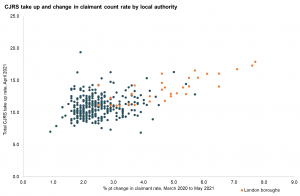June 2021
1. The labour market shows signs of recovery with employment rising as the economy gradually reopened
Employment rose by 113,000 in February to April 2021 compared to the previous quarter, but is 353,000 lower than a year ago. The timelier measure of PAYE employees rose by 196,800 in May 2021 compared to the previous month, but is 507,700 lower than in March 2020.
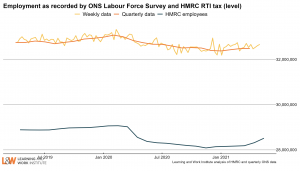
Unemployment is 1.613 million in February-April 2021, 246,000 higher than a year ago, but 90,000 lower than in the previous quarter. The number of people claiming unemployment-related benefits fell by 92,600 in May 2021 compared to the previous month, to stand at 2.50 million. Increased employment support from Jobcentre Plus could help to bring claimant unemployment more in line with the survey measure of unemployment in the months ahead.
After a sharp initial impact in Spring 2020, there have been smaller changes in employment and unemployment overall than would be expected given the fall in economic output. We estimate unemployment would be around 2.5 million higher had it followed the path of economic output. Instead, the furlough scheme has helped to protect jobs.
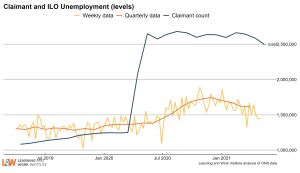
2. Labour demand is rising, with online vacancies now above pre-pandemic levels across the country and hours worked rising as people return from furlough
The number of online vacancies as measured by Adzuna fell by two thirds two thirds during the Spring 2020 lockdown but is now above its pre-crisis levels, though with significant sectoral and geographical variations. There are anecdotal reports of some employers struggling to fill vacancies in some sectors and some parts of the country, pointing to the need for high quality employment support to link those out of work to these vacancies.
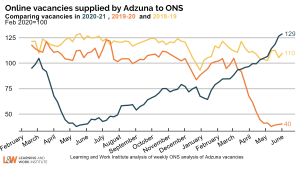
The furlough scheme and other economic support have protected millions of jobs and meant the labour market adjusted to lockdowns more through hours worked than by changes in employment. With lockdowns now easing across the country, the total number of hours worked returned to 94% of the February 2020 level at the end of May after an earlier reduction during the November-March lockdowns.
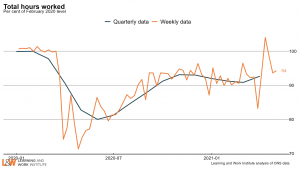
In significant part, this reflects falls in the number of people furloughed. This reflects the end of the latest lockdown. The number of people furloughed rose to 4.9 million in February 2021, compared to 4 million in December 2020, but had fallen to 3.4 million at the end of April 2021 (of whom 2.0m were fully furloughed).
However, there are signs of a potential mismatch with anecdotal reports of employers finding some vacancies difficult to fill and sharp rises in the number of people in temporary work involuntarily: 506,000 people in temporary work, 32.2% % of the total, want to be in more permanent work. This could reflect a mismatch in the labour market, or employer caution in taking on permanent staff as the economy slowly reopens. More than 1 million people are working part-time because they could not find a full-time job, 13.1% of all part-time workers.
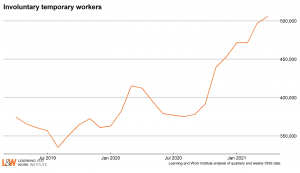
3. Young people continue to be among those hardest hit
Young people account for 60% of the fall in employment, despite accounting for just 12% of total employment. As a result, the number of unemployed 16-24 year olds has risen 16,000 since the last pre-pandemic figure and 477,900 18-24 year olds are claiming unemployment-related benefits, double pre-crisis levels.
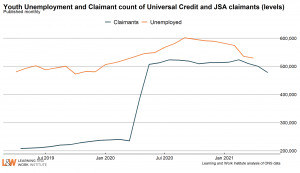
The number of young people unemployed for 6 months or more has risen this month. There were 215,000 long-term unemployed young people in February to April 2021, up 48% since the last pre-pandemic figure.
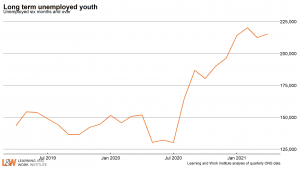
We continue to argue for a Youth Guarantee to ensure all 16-24 year olds are offered a job, training place or apprenticeship. That includes for the 500,000 young people estimated to be leaving full-time education this summer.
4. Furlough rates have fallen but remain high in many parts of the country
Furlough rates fell across the country during April as the economy began to reopen. Nationally, total take-up rates decreased from 15% at the end of March to 12% by the end of April, and rates fell in every local authority area.
But furlough rates remain relatively high in many parts of the country, particularly those that have seen sharp increases in the claimant rate. More than one in six employments in the London boroughs of Brent, Haringey and Newham were furloughed at the end of April – areas that have seen among the highest claimant count rate increases since March 2020.
